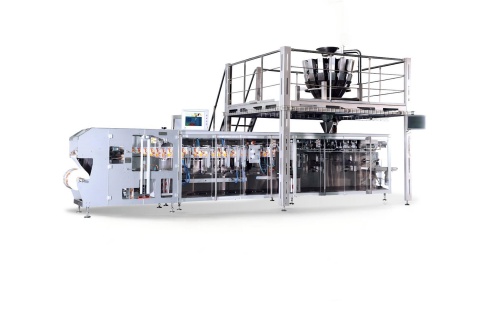How to Maintain and Service Your Roll Film Horizontal Packaging Machine Effectively?
Imagine this: your production line is running at full speed, and suddenly, your horizontal roll film packaging machine jams. Seals are uneven, film tears, or the machine stops entirely. Downtime hits, orders pile up, and your team scrambles to fix it. This isn’t just a hassle—it costs you time, money, and customer trust. For businesses like yours—whether you’re packaging snacks, frozen veggies, dairy products, or grains—unplanned machine issues can derail your entire operation.
Many food and beverage processors, farms, and packaging plants focus on production targets but overlook a critical factor: regular maintenance. They wait for breakdowns to happen instead of preventing them. Over time, small problems—like worn parts, film residue buildup, or misaligned components—turn into big, expensive repairs. Machines age faster, performance drops, and you end up replacing equipment sooner than you should.
The good news? Most of these issues are avoidable. With a simple, consistent maintenance routine, you can keep your HFFS machine running smoothly, reduce downtime, extend its lifespan, and ensure your packaging stays high-quality. In this guide, I’ll walk you through practical, step-by-step maintenance tips tailored to your needs—whether you run a large dairy plant, a fruit processing facility, or a busy snack food factory.
Answer to the Title Question: To maintain your roll film horizontal packaging machine effectively, focus on daily cleaning, regular inspection of key parts (like seals, blades, and film guides), timely replacement of worn components, lubrication of moving parts, and staff training. By following these steps, you’ll prevent breakdowns, ensure consistent packaging quality, and extend your machine’s life by years. Let’s break this down into actionable habits.

1. Daily Cleaning: Start with the Basics
Problem: Film residue, food particles, and oil buildup are silent enemies of your machine. Even small bits of debris can clog sensors, misalign film paths, or damage seals. If you skip cleaning, your machine has to work harder, and packaging quality suffers—think leaky seals on ketchup bags or torn film on suction nozzle bag.I’ve visited plants where operators wipe down machines quickly at the end of the day, but they miss hidden areas: under the forming tube, around the sealing jaws, or inside the film unwind unit. Over time, this gunk hardens, making it harder to clean and increasing the risk of jams.
Solve: Make daily cleaning a non-negotiable step. Here’s how:
· After each shift: Use a soft brush or lint-free cloth to wipe down the film path, sealing bars, and cutting blades. Remove any food crumbs, film scraps, or dust.
· Focus on high-residue areas: The forming shoulder (where film shapes into a pouch), heat seal bars, and the cutting knife are magnets for buildup. Use a mild, food-safe cleaner (avoid harsh chemicals that damage film or parts) and a non-abrasive sponge to wipe these areas.
· Dry thoroughly: Moisture causes rust, especially on metal parts like seal bars and blades. After cleaning, dry all surfaces with a clean cloth.
Why this works for you: Daily cleaning takes 10–15 minutes but prevents 80% of common jams and seal issues. For example, a snack food plant I worked with reduced film tears by 60% just by adding a 5-minute end-of-shift wipe-down of their seal bars.
2. Inspect Key Components Weekly
Problem: Worn or damaged parts are often the root cause of machine failures. A cracked seal bar, a dull cutting blade, or a loose film guide might not seem like a big deal on Monday, but by Friday, they can shut down your line.Many teams only check parts when something goes wrong. But by then, the damage is done. For instance, a dairy processor once told me their machine started producing leaky milk cartons. The issue? A tiny nick in the heat seal bar that had been there for weeks, growing worse each day. They had to replace the bar and lost 8 hours of production.
Solve: Set a weekly 30-minute inspection time. Grab a checklist and walk through these critical parts:
· Heat seal bars: Look for cracks, dents, or uneven wear. If the surface is rough or pitted, seals will be weak. Replace worn bars immediately.
· Cutting blades: Check if they’re sharp and aligned. Dull blades tear film instead of cutting cleanly. If you see frayed edges on packages, it’s time to sharpen or replace the blade.
· Film guides and rollers: Ensure they’re clean, smooth, and tightly secured. Loose guides cause film to misalign, leading to crooked seals or jams.
· Belts and chains: Look for cracks, fraying, or slack. Tighten loose belts; replace any that show signs of wear.
· Sensors and controls: Wipe sensor lenses (dust blocks signals) and test buttons/settings to make sure they respond correctly.
Why this works for you: Weekly inspections catch small issues before they escalate. A fruit processing plant I advised started doing this and cut unplanned downtime by 60% in three months.

3. Lubricate Moving Parts Monthly
Problem: Moving parts like gears, bearings, and hinges need lubrication to reduce friction. Without it, metal rubs against metal, causing overheating, wear, and eventually, breakdowns.Some operators skip lubrication because they “don’t have time” or use the wrong product. A grain processor once used motor oil on their machine’s gears—big mistake. The oil attracted dust, gunked up the parts, and led to a costly gear replacement.
Solve: Monthly lubrication is simple if you follow these rules:
· Use the right lubricant: Check your machine manual for the recommended type (e.g., food-grade grease for parts near product areas). Never use non-food-safe oils—they can contaminate products.
· Lubricate only moving parts: Focus on gears, chain links, pivot points, and bearing housings. Avoid lubricating seal bars, blades, or film contact surfaces (oil ruins film adhesion).
· Wipe excess grease: Too much lubricant attracts dust. Apply a thin, even layer and wipe off any drips.
Why this works for you: Proper lubrication reduces wear and tear, keeping parts moving smoothly. A vegetable packaging plant extended their machine’s gear life by two years just by sticking to a monthly lubrication schedule.
4. Train Your Team on Basic Troubleshooting
Problem: Even with great maintenance, small issues pop up. If your operators don’t know how to fix simple problems—like a minor film jam or misaligned guide—they’ll wait for a technician, wasting time.I visited a large farm that packaged frozen corn. One day, the film kept slipping off the rollers. The operator didn’t know how to adjust the tension, so the line sat idle for 2 hours until the maintenance guy arrived. The fix? A 30-second tweak to the film tension knob.
Solve: Train your team to handle common issues. Run short, monthly workshops covering:
· How to clear film jams safely (always turn off power first!).
· Adjusting film tension and alignment.
· Cleaning sensors when the machine “thinks” there’s a jam (even when there isn’t).
· Replacing small, easy parts like blades or O-rings (keep spares on hand!).
Why this works for you: Empowered operators fix small problems fast. A snack food company cut “wait time” for minor issues from 1 hour to 10 minutes after training their team.

5. Partner with Your Supplier for Professional Servicing
Problem: Some tasks are too big for in-house teams. Motors, electrical systems, or complex mechanical repairs need a pro’s touch.A beverage processor tried to repair a faulty motor themselves to save money. They miswired it, causing a short circuit that damaged the entire control panel. The repair cost tripled, and downtime lasted 3 days.
Solve: Schedule annual professional servicing with your machine supplier or a certified technician. They’ll:
· Deep-clean internal components you can’t reach.
· Test electrical systems for safety and efficiency.
· Replace worn parts you might have missed (like hidden bearings).
· Update software for better performance.
Why this works for you: Professional servicing catches hidden issues and keeps your machine up to factory standards. Think of it like a car’s annual tune-up—it prevents major breakdowns down the line.
Conclusion
Your horizontal roll film packaging machine is the backbone of your packaging line. It works hard every day to keep your products fresh, safe, and ready for customers. By following these steps—daily cleaning, weekly inspections, monthly lubrication, team training, and annual professional servicing—you’ll keep it running strong for years.You don’t need to be a mechanic to do this. It’s about consistency, not complexity. Start small: pick one task this week (like daily cleaning) and build from there. Your machine, your team, and your bottom line will thank you.
What’s your first step? Grab a cloth and clean those seal bars today. You’ll be surprised how much smoother tomorrow’s production runs.
Let’s keep your line moving!
Union Machinery has been engaged in food machinery customization services since its establishment in 2014, according to customer needs for you to tailor suitable machinery and equipment, for more product information, please refer to: Automatic-Horizontal-Packaging-Machine/; Suction Bag Horizontal Packaging Machine;Four Side Sealing Horizontal Packaging Machine; Special Shaped Bag Horizontal Packaging Machine; Rice Roll Film Horizontal Packaging Machine; Our expertise and advantages will bring you more opportunities and development space.
For personalized, industry-tailored advice and to explore state-of-the-art solutions, please don't hesitate to contact us at info@unmachinery.com
The following is other knowledge related to the Horizontal packaging machine that I have summarized based on long-term work experience, for your reference. I hope it will be helpful to you.
1.What is the horizontal bag making packer?
2.What is a premade bag horizontal packaging machine?
3.What are the common faults of the roll film horizontal packaging machine?
4.How to choose an excellent roll film horizontal packaging machine?
5.How to choose between horizontal packaging machine and vertical packaging machine?







